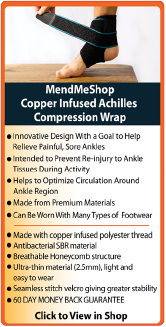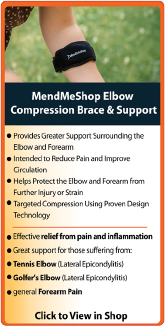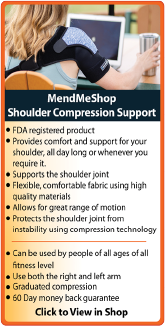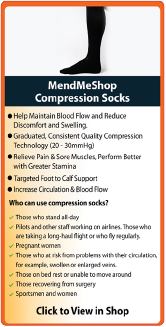Knee Bursitis"Aseptic bursitis" will happen when your bursa isn't infected but your bursitis has been caused by inflammation from another soft tissue injury. For knee bursitis this might mean that you've hurt some of the soft tissue in the knee from a trauma (like a fall) or from repetitive damage over time as can be imagined from certain professions such as carpet installation or roofing. Bursae in the knee are most often injured from overuse or as a result from excessive strain (even a traumatic accident or fall). Bursitis is most common in males (80%) between the age of 40 and 60; however bursitis that occurs due to trauma is most common before the age of 35. (reference: link) Poor posture, knee joint degeneration (arthritis, osteoarthritis), auto-immune disorders (gout, psoriasis, thyroid disease), previous surgical intervention, bone spurs / calcium deposits, prolonged kneeling and leg-length discrepancy (one leg is shorter than the other) are all risk factors for knee bursitis (reference: 1). Basically, degenerative conditions affecting the knee or any type of injury or condition that alters the way you walk, stand or sit can lead to a change in the position of the bones and tissue in the knee joint - and these changes in positioning can result in knee bursitis. Degenerative conditions like osteoarthritis or arthritis, can also be hereditary; you may experience more problems in your knee and/or hip if you have older family members that have suffered from similar conditions in the past. Everyone can be affected by degeneration of their knee joints over time. As we age, our tissue ages too. Any repetitive or frequent movement can place stress on the bursae in your knee over the years. This includes restricted movement due to sitting at a desk job for years, careers that require constant knee bending or resting on the knees, or even physical activities on the weekend. Be aware that knee bursitis can happen to anyone - especially if due to trauma - and it is not just something that happens to someone else. In most cases, mild to moderate knee bursitis can be treated through conservative treatments outlined by a physician. Recovery from knee bursitis can take a long time but proper healing is essential to regain strength and get you back to the activities you enjoy. Complete recovery can be easily delayed by re-injury to the tendons, ligaments or other soft tissue in your knee.  It's almost impossible to keep from re-injuring soft tissue in your knee - especially if you incur knee bursitis due to an overuse injury. If you don't take care to remove the underlying cause of your knee bursitis you will always be at risk of re-injury. Sometimes though, it's just not possible to stop everything and rest the injury properly; if your job is the reason you are suffering from knee bursitis, you need to seriously evaluate whether you should change professions - at least temporarily. What ends up happening is we continually re-injure tissue in the knee through our work and daily activities and suffer through on-going flare-ups of knee bursitis - continually setting back our recovery time. Unless you seriously choose to rest your knee and let the injury heal, you will find that 100% recovery is nearly impossible without proper treatment. Eventually, if left untreated, you might have chronic inflammation of your bursa and/or surrounding soft tissue; treatment becomes even more problematic at this point (you might need surgery to remove your bursa). Prepatellar BursitisPrepatellar Bursitis is also known as "housemaid's knee" The prepatellar bursa is located in front of the kneecap and takes the form of a flat, round structure. Its main function is to separate the kneecap from the patellar tendon and skin on the front of the knee. Prepatellar bursitis has historically been known as Housemaid's Knee as this condition is often associated with people whose work required kneeling for extended periods of time. Learn more about prepatellar bursitis here. Infrapatellar BursitisInfrapatellar Bursitis is sometimes known as "clergyman's knee, plumber's knee, parson's knee, vicar's knee, hoe's knee" There are 2 infrapatellar bursa and both are located below the kneecap. The deep infrapatellar bursa lies beneath the patella tendon - the tendon connecting the kneecap to the tibia bone (lower leg). The superficial infrapatellar bursa lies in front of (or above) the patellar tendon. Despite the fact that they lie on opposite sides of the patellar tendon, it can be difficult to determine whether one or the other (or both) are causing discomfort. Learn more about infrapatellar bursitis. Pes Anserine BursitisPes Anserine Bursitis is also known as "goosefoot bursitis" There is an area just below the knee joint on the inside (medial) part of the leg where the sartorius, gracilis and semitendinosus muscles (these are basically hamstring muscles) attach to the tibia (lower leg bone) just above the shin. These 3 muscles attach via tendons and these tendons effectively join together as they approach the bone. If you look at an image of the tendons, the form is similar to a goosefoot - ergo the term goosefoot tendon. There is a bursa between the goosefoot tendon and the tibia bone to prevent the tendon rubbing against bone, and this bursa is the pes anserine bursa, or more commonly termed the "goosefoot" bursa. Learn more about pes anserine bursitis here. General Information about BursitisImportant: In some cases, an inflamed bursa may become infected with bacteria (referred to as septic bursitis) and this can quickly become life threatening! In all cases where you suspect you may have bursitis, see a physician for full diagnosis. If the bursa is septic (infected), getting to a doctor quickly may save your life. There are two types of bursitis: chronic and acute. Chronic bursitis is caused by overuse or repetition of a certain area or joint. It will develop over time, and will likely get better and flare up over a long period of time. Acute bursitis is often the result of a trauma to the knee, such as a fall. It can also result from a simple movement such as lifting and twisting the wrong way or may come on quickly following irritation during knee surgery. Some suffers cannot recall what triggered the knee pain, which is why some will not seek treatment, hoping it will resolve itself. However, it is always wise to address and deal with knee pain as soon as possible so that the problem does not worsen. Knee Bursitis SymptomsA healthy knee bursa is typically quite small, but it can swell very significantly when bursitis sets in. This is what creates the soft tissue damage in the area. Most symptoms of knee bursitis are specific to which type of knee bursitis you have, also common symptoms you may experience include:
Knee Bursitis CausesBursitis of the knee has been found to be statistically more prevalent in cases where the sufferer is involved in, or experiences one or more of the following factors: 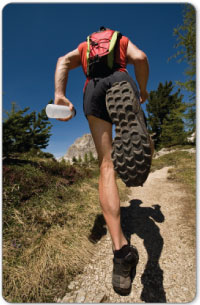
The Painful Symptoms of Acute & Chronic Knee BursitisThe pain you'll feel for acute (short-term) vs. chronic (long-term) knee bursitis will be different. In the beginning you might feel a sharp, intense pain at your knee - however, the longer you have this injury the more this pain is likely to spread out into more of an achy feeling. One clear sign that you've re-injured your knee while recovering from knee bursitis is feeling that sharp, intense pain again if you've overworked it. You may even notice an intense pain while getting up from a seated position - especially if you have a desk job, spend a lot of time seated on the couch or a kitchen chair during your "down time" or drive in your car for long distances. Over time, if left untreated, you will start noticing more and more constant pain and have trouble sleeping at night. As I mentioned before, if this injury is left untreated you might need to get your bursa removed through surgery (a bursectomy). You might even suffer from "septic" bursitis - where your bursa gets infected by a bacteria. On-going pain, chronic swelling, or symptoms of an infection (fever or a general sick feeling) should be treated immediately by a doctor. What Should I Do?If you think that you're suffering from knee bursitis and your mobility is steadily declining, the first thing you need to do is see your doctor. Only your doctor can give you a proper diagnosis and from this, determine a course of proper treatment. If you've been diagnosed with knee bursitis,
... and Re-injury to your knee must be avoided at all costs!Time is no friend to an immobilized joint - you lose strength in your knee but worse than that, you lose the range of motion from atrophy (your flexible tendons, muscles and ligaments slowly shrink / waste away, decreasing joint elasticity). The more time that goes by with your knee immobilized, the more likely you'll wind up with a chronic problem (long term injury such as tendonitis or chronic inflammation / bursitis pain). Basically it means that your knee won't perform as well as it once did and it becomes more prone to injury again later on. If you have an inflamed bursa in your knee, it's very important to heal it quickly and completely. Minimizing the healing time of your knee bursitis should be an obvious goal, as knee bursitis will limit your ability to go about your daily routine. As stated here (MedicineNet.com), if your long-term (chronic) knee bursitis is left untreated, calcium deposits can form within the bursae. These calcium deposits can lead to permanent stiffness in your injured knee. Dealing with continuous re-injury, chronic inflammation / swelling and the possibility of getting calcium deposits means you'll have a greater chance of winding up with a chronic knee condition or a serious case that needs to be resolved with surgery. You need to avoid chronic inflammation and the potential for developing calcium deposits. If you don't, your knee bursitis injury may plague you forever. This is why it's so important to continuously use conservative treatment tools to heal any recurring soft tissue damage and swelling from your bursa before it can build into something big. For any knee bursitis sufferer, having the right tools makes all the difference. Read more about bursitis home treatment options here. Product Advisors are available 9:00 am to 5:00 pm Eastern Standard Time Monday to Friday. Learn More About Bursitis Injuries & TreatmentsI want to learn more about Post-Surgery Recovery I want to learn more about TShellz Wrap® Circulatory Boost I want to learn more about Ice & Heat: Which Is Better For Treatment? I want to learn more about Bursitis Treatments I want to learn more about Bursitis Surgery FREE SHIPPING ON ALL PRODUCTS CURRENTLY ENABLED |
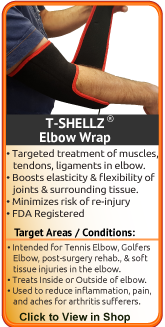  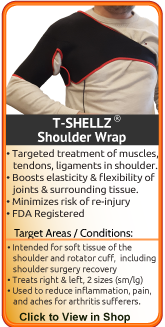 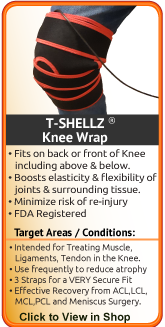 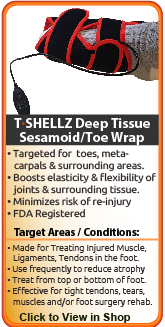  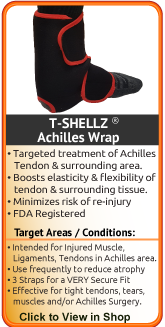 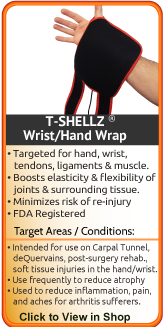 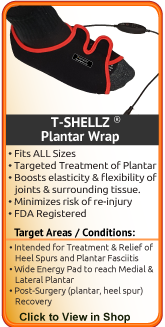  |

